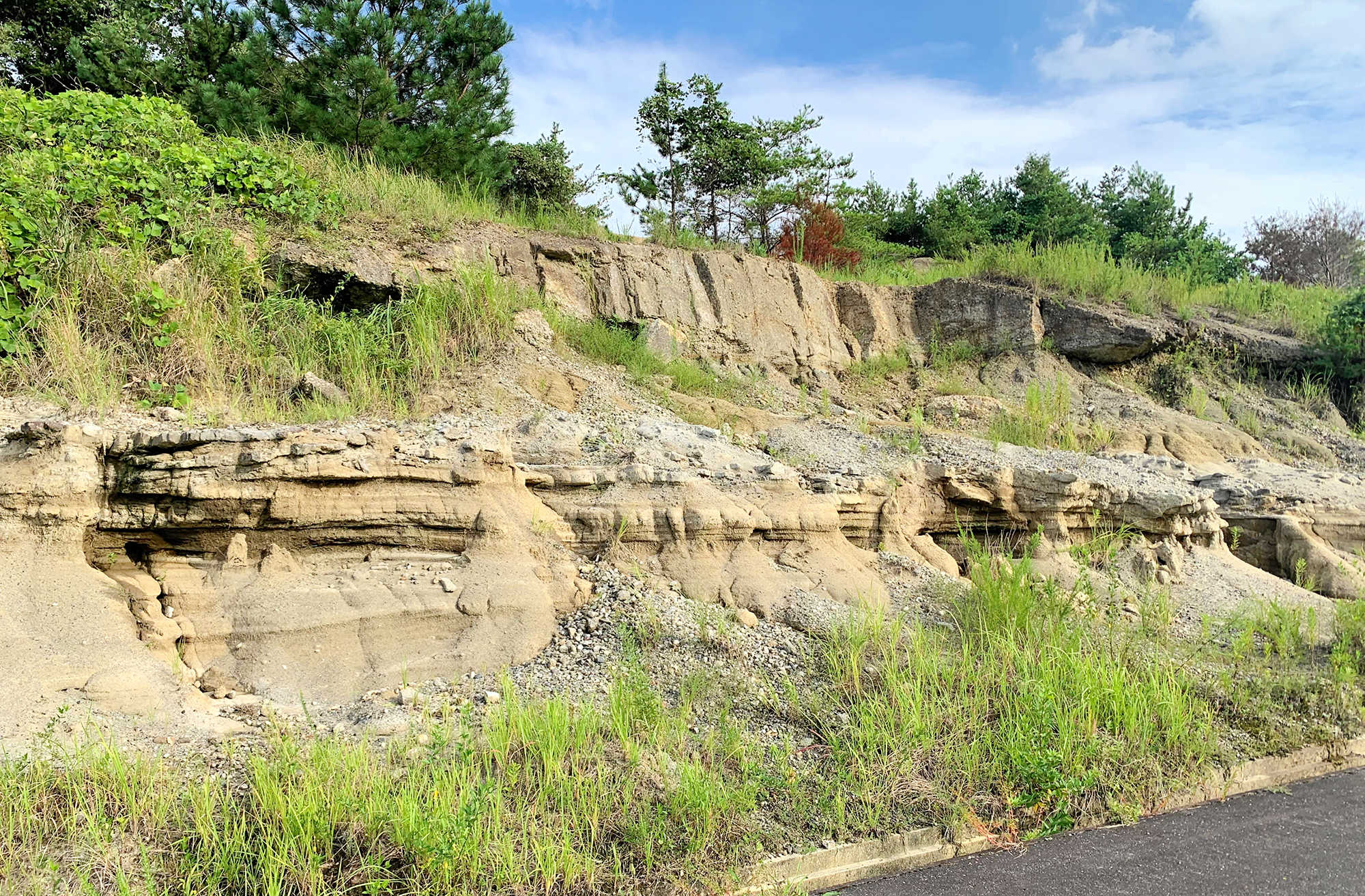Yamada Nishiki: 85-year legacy, an exceptional sake rice
Muramai (sake rice) flags
From the centre of Miki City, the route takes you along a prefectural road heading upstream of the Mino River, a tributary of the Kako River. After a while driving through the green carpet-like surroundings of rice fields, a row of flags appears alongside the rice fields. These are the ‘muramai’ flags, which indicate contracted cultivation between the Yamada Nishiki producers and a sake brewery. The brewery and brand names are written on the flag. The light blue colour is used by Nishinomiya's ‘Hakushika’. While ‘Hakkaisan' is a brewery from Niigata, and ‘Katsuyama’ is from Sendai.
Continuing further along, a flag with a logo familiar to locals comes into sight. It’s the logo for Kenbishi sake brewery in Higashinada Ward, Kobe City. In 2007, they started raising their muramai flag early, when the rice field was still green. The company's president,Masataka Shirakashi, overlooks the green-eared rice fields, sharing about how the "flags are put up in June when the rice is planted, but they don't last for a season due to rain and wind. We replace the damaged ones."
Yamada Nishiki from Hyogo Prefecture is an exceptional sake rice. There are said to be around 1,200 sake breweries nationwide. Of these, 550 breweries, including many famous brands, use Yamada Nishiki from Hyogo.
It has been 85 years since Yamada Nishiki was cultivated for the first time in Hyogo. And since then, many varieties of sake rice have been developed all over Japan. However, a sake rice that rivals Yamada Nishiki, which is highly regarded for its ease of polishing and fermentation, has yet to emerge.

The Kenbishi flag has been erected in Yamada Nishiki rice fields since 2007. The person holding it is Masataka Shirakashi, president of Kenbishi Sake Brewery (Yokawa-cho, Miki City)
East to West Valley
There is a saying that continues to be used in the growing region since old times. It goes, “If you want to buy rice for sake, buy land”. The primary feature of a good growing region is that it is located in a valley running east to west. Main growing regions such as Kita Harima, Kita Ward in Kobe City, and Sanda City, that have a historically good reputation and is popular among brewers form what is called the ‘Special A District’. Take a look at this map created based on a map comprised by Hyogo Prefecture. You can find a similar map to this included in the Japanese Sake Textbook for the Japan Sommelier Association Certification Examination.
.jpg)
The blue dots are villages ranked as ‘Special A-b’ growing areas. The red dots are villages with ‘Special A-a' ranked growing conditions. This is the highest rank awarded and can be found concentrated in valleys that run from east to west, along the Mino River in Miki City and the Tojo River in Kato City. Of course, valleys running north to south have their merits too. The main of which is the fact that they get a lot of sunlight in the day, and there is a great difference in temperature between day and night.
On the other hand, the greatest advantage of a valley running from east to west in the case of the Rokko Mountain Range is that they block the warm southerly winds blowing from the Seto Inland Sea, making it easier for the temperature to drop at night, which is necessary for excellent rice cultivation.
The late Iwao Morimoto, who served as the first executive director of the Sake Rice Promotion Association from 1961, was responsible for researching the topography and climate of the growing regions. The story of the research is described in ‘Yamada Nishiki Monogatari', or ‘The tales of Yamada Nishiki’, published by the Hyogo Sake Rice Research Group, which is comprised of Hyogo Prefecture officials.
On hot summer days, warm air currents from the ocean blow northward through the Harima Plain in the Kako River basin. The airflow also rushes into the tributary Mino River basin, but for some reason stops midway. The same goes for the wind that flows into the Tojo River. Mr. Morimoto explains that this is due to the cold air currents blowing from the deep forests of Tamba beyond the river.
Kobe Group

Strata of the Kobe Group discovered during farmland development = Yokawa-cho, Miki City
Another feature of growing regions is their geology. Many of the Special A Regions are distributed in a stratum called the ‘Kobe Group’. This area is known for its geological formation where many beautiful plant leaf fossils can be found.According to recent research, the Kobe Group was formed from sediments from 30 to 40 million years ago. "Recently, the general view is that the geological formations were formed by alternating periods of times when there were many small rivers, and times when they were lakes" explained researcher Kumiko Handa, Director of the Prefectural Museum of Nature and Human Activities (Sanda City). A study by the Hyogo Prefectural Technology Centre for Agriculture, Forestry and Fisheries found that land for rice cultivation here has a thick layer of clay and a small layer of gravel, making it easier for rice to grow roots.
However, there are also aspects such as the increased risk of landslides due to water accumulating between one clay layer and another. Maintaining farmland is a difficult task, as the stonework of rice terraces can sometimes collapse. Hideki Morimoto, a Yamada Nishiki farmer in Yokawa-cho, Miki City, says, "if it rains heavily after draining the rice fields and drying them in the summer, water can get into the cracks created by the drying and cause the ridges to collapse. The soil here is not easy to work with. However, it is highly efficient at retaining minerals and other nutrients" he says of the advantages of the soil that he works with.
Just like in the wine industry, some breweries are beginning to share information about the soil that grows sake rice from a sake brewing perspective. Honda Shoten, a vendor in Himeji City is particularly demanding about Special A Regions, such as ‘Akitsu’ in the Tojo district of Kato City. The renowned brand ‘Tatsuriki’ that uses Yamada Nishiki in its brewing opened the ‘Tatsuriki Terroir Centre’ in November 2020 to introduce the cultivation soil for Yamada Nishiki production. Visitors can learn about the composition and properties of the soil in the three Special A-a Regions of ‘Sha’ (Kato City), ‘Tojo’ (Kato City), and ‘Yokawa’ (Miki City). Yamada Nishiki harvested in these three production areas are used to produce sake using the same method, and this sake is available for purchase. Visitors can enjoy the unique differences in taste.

Ryusuke Honda, Managing Director of Honda Shoten, talks about the relationship between the soil used in production
and sake at the Tatsuriki Terroir Centre, Aboshi Ward, Himeji City.
Ryusuke Honda, Managing Director of Honda Shoten, explained that using sake rice grown in Special A Regions with similar conditions such as being blessed with sunshine and climatic conditions, that different soils produce different tastes. And it was when he was trying to explain this phenomenon that he came across the term widely used in the world of wine, ‘terroir’.
Seeds from 14 lineages
Yamada Nishiki from Hyogo is unrivalled by other sake rice. Its excellent quality is maintained through unrelenting efforts to protect the seeds. In Hyogo Prefecture, 14 strains of Yamada Nishiki are cultivated to preserve their genetic characteristics. Then, each plant goes through rigorous examination, and only the seeds from those approved for selection are recognised as breeder seeds. This is how Yamada Nishiki is maintained. From the following year onwards, the breeder seeds and foundation seeds are grown, and from then the fourth progeny seeds are supplied to farmers the following year for rice cultivation. The rice that reaches the sake brewery is the 5th progeny.
Yamada Nishiki which is protected in this way is actually as a rice variety one that is much more difficult to cultivate than other modern varieties. First of all, it is 125 centimetres tall, which is 20 centimetres longer than the Koshihikari strain. This poses some difficulties because if too much fertilizer is used, it tends to fall over, and since they are harvested in October, the late cultivation period means they are susceptible to damage from typhoons. Additionally, this variety has a relatively low yield and is susceptible to diseases.
Due to competition from other strains of sake rice from various regions, efforts have been made to improve Yamada Nishiki, in particular by reducing its height. Then along came the ginjo sake boom of the 1990s. Among brewers, Yamada Nishiki rice was highly praised for its features such as remaining undamaged even when polished to half its size and being easy to ferment slowly at low temperatures, making it even more special. "When trying to create a new rice strain, we try to incorporate new advantageous characteristics, but once we achieve that, we focus on maintaining those characteristics,'' explained Masaru Ikegami, Head Researcher of the Prefectural Sake Rice Experimental Site (Kato City), the only research institute in the country specializing in sake rice.
Even though the downsides of Yamada Nishiki have been pointed out, such as being difficult to grow and having low yields, researchers have consistently maintained the original characteristics of Yamada Nishiki. And farmers faithfully continue to grow it in their rice fields. It can be said that the connection between the two has given Yamada Nishiki, which is native to Hyogo, even more appeal.
Yamada Nishiki can be compared to how Tajima cattle are bred. Tajima cattle has stubbornly maintained its petite frame in the face of ever growing larger Wagyu cattle that pose competition domestically.
As the reputation of Japanese sake increases in the world of wine sommeliers and chefs overseas, Yamada Nishiki and Hyogo are increasingly being looked at from a terroir* perspective, which emphasizes ingredients and climate.
We hope that the story of our miraculous sake rice will continue to stand out and go on to be shared more widely.
*A French word used in the wine industry to refer to the various natural environments that determine taste and aroma. This includes not only the soil composition and drainage of the vineyard where the raw materials are grown, but also weather conditions such as sunlight, temperature, rainfall, and wind direction, as well as the techniques of the farmers and winemakers. In France, it is said that the winemaker's calling is to bring out the terroir to its fullest extent, and by specifying the terroir in detail, wine producers can emphasize the flavours and aromas that are rooted in the region. In Japan, we can see a growing movement in the sake and tea industries to share information about production areas and food culture making the terroir approach more accessible.
Written by Kazuyoshi Tsujimoto, Manager of Corporate Planning Department, Senior Staff Writer at The Kobe Shimbun (Daily Newspaper)
This article was first published on 19th September 2021 in The Kobe Shimbun as part of a series entitled "Wind, Water and Earth...Hyogo's Terroir"
Date : 2024.05.29




